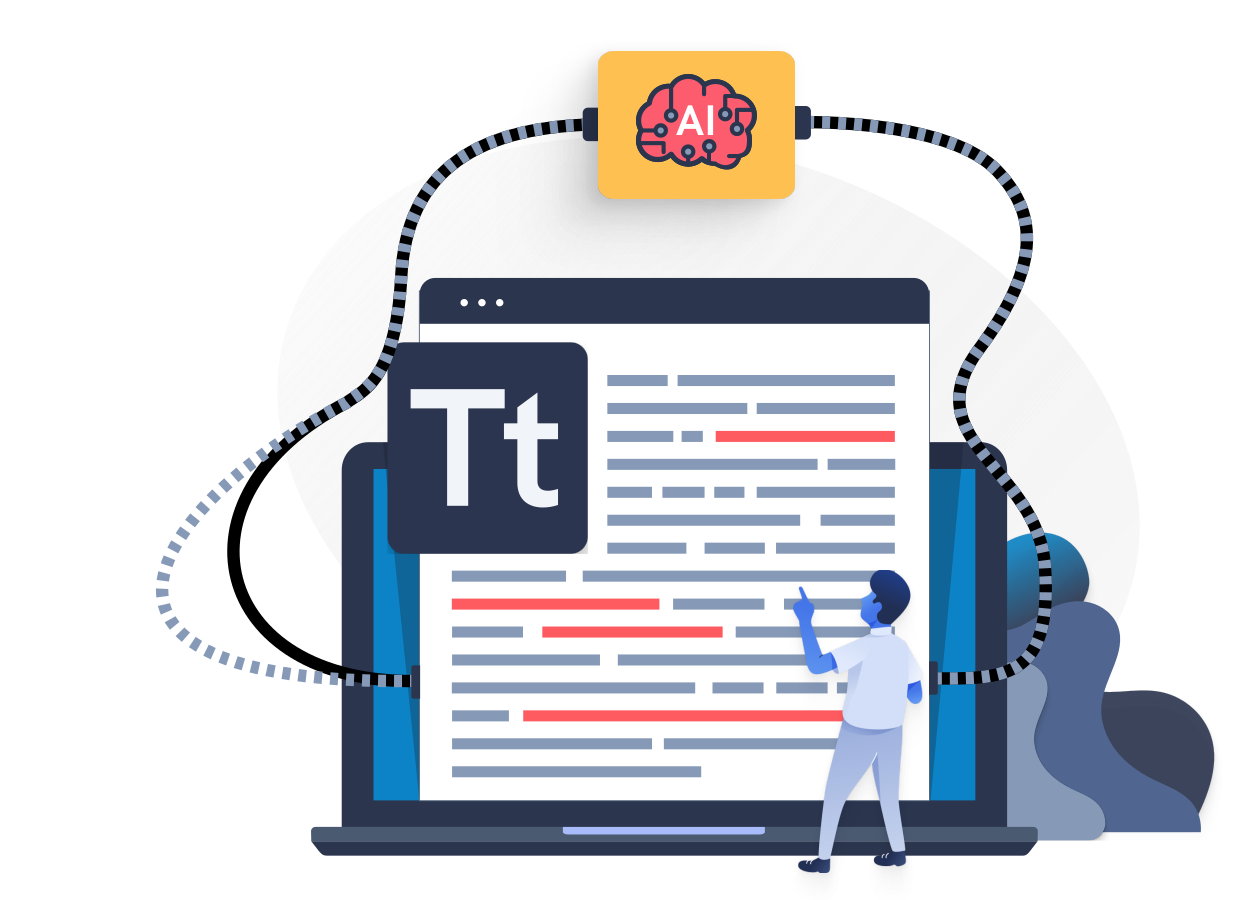These days, with AI tools writing everything from essays to emails, it’s hard to know if a piece of content was crafted by a person or a machine. That’s where Quetext’s AI Detection steps in. Our tool examines text for patterns, tone, and structure that are commonly found in content generated by large language models like ChatGPT or Claude.
It’s not about punishing the use of AI it’s about maintaining transparency. Whether you're reviewing student submissions, assessing a job application, or just curious if your content sounds “too AI,” Quetext gives you a clear, no-pressure analysis you can understand.
Confidence Scoring & Linguistic Insights
Many AI detectors throw out a vague percentage and leave you guessing. Not here. Quetext shows a confidence level based on linguistic patterns, repetition, and syntactic features. This includes:
Predictability of word choice
Sentence rhythm and structural repetition
Lack of personalisation or narrative variance
These signals don’t just say “yes” or “no.” They help you understand why the text might feel machine-written so you can revise it, own it, or flag it as needed.
Citation Generator
Citing your sources properly can be tricky and time-consuming. With Quetext, you can instantly generate citations in popular formats like APA, MLA, and Chicago. That takes a huge load off your plate especially during midterms or finals when time is tight.
Bonus: this feature also helps you avoid unintentional plagiarism caused by missing or improperly formatted citations.
AITutorMe
Need help rephrasing content to make it more original? AITutorMe is your built-in writing coach. It doesn’t just swap words; it helps you rewrite sentences while preserving your intended meaning and improving clarity. Whether you're refining a rough draft or reworking flagged content, AITutorMe makes the revision process faster, easier, and more thoughtful, so your writing always sounds like you, just better.
Our AI content checker provides our subscribers with the confidence to know the content they check was written by a human.
Building upon our language-processing expertise, Quetext’s AI detection looks at content holistically, and sentence-by-sentence, to provide users with a greater degree of certainty than other AI detectors.
Whether an entire document, or one small section appears to be AI generated, Quetext calls it to your attention.


Whether you suspect content was written by Bard (Google), ChatGPT (OpenAI), GPT-3, GPT-4, LLaMA (Meta), and other models as well as content generators based on these models, our artificial intelligence content detector finds it and flags it for your review. We've built a robust AI detection tool that works with the leading AI content generators today and tomorrow.
By training our AI content detector to work with multiple language models used by popular artificial intelligence bots, our tool confidently separates AI generated text from human written text.
Our technology works to identify telltale signs of AI, which may include sentence structure, grammar, tenses, vocabulary, repeated phrases, and other signals, at the sentence and document level, to provide our subscribers with confidence in using our tool over others in the industry.
In mere moments, our AI detector provides our subscribers with a confidence score for their unique content. Using advanced algorithms, our detector analyzes entire documents in detail, providing fast and reliable results.
Based on those results, you can take immediate action to maintain the integrity and credibility of your content.

Whether it’s created by Bard (Google), ChatGPT (OpenAI), GPT-3, GPT-4, LLaMA (Meta), or other AI content generators to come, Quetext’s AI detector identifies non-human generated content.
Simple and easy to use, subscribers can copy and paste the content they’d like to check and click “Detect AI”.
Our AI detection tool immediately gets to work for you, analyzing your content at the sentence and document level, providing you with peace of mind.
Once complete, our detector provides you with clear results, showing the likelihood of content being written by a human, or artificial intelligence.
AI writing often falls into repetition reusing similar sentence starters or transitional phrases across paragraphs. You might notice the same structure repeating (“In conclusion,” “Furthermore,” “It is important to note”) even when variety would sound more natural.
Lack of Emotion or Human Nuance
While AI is good at stringing words together, it lacks real-life experience. That means it struggles to express emotion, subtle humour, or genuine empathy. The tone may feel overly formal or strangely flat, even when discussing personal or emotional topics.
Overuse of Transitions or Passive Voice
AI models tend to lean heavily on linking phrases and passive constructions. This can make the text sound robotic or overly polished like it's been optimized for coherence rather than personality.
Formulaic Structure
Most AI-generated content sticks to a rigid template: introduction, three supporting points, and a conclusion. While this isn’t wrong, the predictability makes the content feel generic or uninspired especially in creative or opinion-based pieces.
Limited Personal Insight
AI doesn’t have memories or opinions. So, if a piece lacks personal anecdotes, first-hand experiences, or subjective reflections, it might be machine written. The absence of “I think,” “In my experience,” or real-world references is often a red flag.
Spotting these signs doesn’t require expert analysis just a bit of practice. And with tools like Quetext’s AI Detector, you can get a clear breakdown of which sections look synthetic and why.
Whether you're ensuring the authenticity of submitted content or reviewing your own writing before turning it in, using an AI detector has become increasingly essential. With the rise of generative tools like ChatGPT, verifying if content is human-written can protect academic integrity, uphold professional standards, and encourage ethical content creation.
A reliable AI detection tool like Quetext provides real-time insights into whether content has likely been machine-generated helping educators, students, and professionals alike make informed decisions. With visual scoring and section-level breakdowns, Quetext empowers users to spot synthetic writing and revise accordingly.
Using AI for writing isn’t always against the rules but transparency matters. Quetext’s AI detector lets students double-check their drafts and make sure their work still sounds like them.
AI Detector For StudentsAI writing tools have changed the way students approach assignments. While innovation in learning is welcome, unchecked use of AI can compromise original thought. Quetext helps educators verify authenticity without playing guessing games.
AI Detector For TeachersQuetext helps academic institutions uphold academic standards by providing AI Detection across campus to evaluate assignments, theses, or any type of student work and enables educators to promote authenticity.
AI Detector For InstitutionsAI-generated text is any text that is created by artificial intelligence models. In this process, AI models use natural language processing techniques and machine learning algorithms. It is often produced by language models, such as chatbots or content generators, which have been trained on large datasets of human-generated text.
AI content detector is a software tool that analyzes text content to determine if it was written by a human or an AI system. It uses machine learning and natural language processing to inspect linguistic patterns and sentence structures to find out if it's AI- written or human-written.
Our AI Content Detector has been highly accurate in testing, consistently providing accurate AI writing detection. Artificial intelligence is a dynamic and rapidly developing field, with new technology emerging constantly, creating an ongoing challenge to continuously enhance solutions, develop new techniques, and train platforms. Quetext’s unique position as the leading plagiarism checker and our leading-edge application of language processing technology provide a distinct advantage in developing and maintaining a leadership role in AI detection.
The accuracy of other AI content detection tools varies depending on the specific detection model and its training data. While these tools have improved over time, they can still have limitations, especially in detecting text generated by ChatGPT models like GPT-2, GPT-3, GPT-3.5, or GPT-4. False positives, where legitimate content is flagged as problematic, can and often occur.
Ongoing research aims to enhance the accuracy of these tools by refining algorithms, expanding training datasets, and addressing challenges associated with detecting AI- generated text. Quetext’s mission is to promote ethical writing practices through originality, including ensuring human-generated content, and we are committed to helping our society and subscribers employ best-in-class technology to achieve their goals and our mission.
Yes, AI detectors work. AI detectors like Quetext aim to identify AI-generated text, but they have limitations. They can produce false positives and false negatives, meaning they may incorrectly flag human-written text or fail to detect AI-generated content due to similarities between the patterns AI detectors are trained on and the submitted content.
Additionally, the accuracy of AI detection tools depends on their specific detection models and training data. While improvements are ongoing, some tools still struggle to detect text generated by models like GPT-2, GPT-3, GPT-3.5, and GPT-4. Ongoing research aims to refine algorithms, expand training datasets, and address challenges in detecting AI-generated text. Quetext remains committed to enhancing AI detection capabilities while promoting ethical writing practices.
Quetext is considered one of the best AI detectors based on multiple tests and reviews from students, professors, and professionals. It leverages advanced natural language processing (NLP) algorithms to analyze patterns, sentence structures, and probability models, helping to distinguish AI-generated text from human writing.
Everyone who works on content in any pattern today uses AI detectors. Educators, content creators, publishers, businesses, and researchers use to analyze the content created by them.
Yes, AI detectors like quetext work on all types of texts but they perform better on longer, structured text but may struggle with short phrases.
AI-generated content is often unique in wording, but not in thought. It’s created by predicting text based on patterns in existing material, meaning it lacks personal insight or lived experience. So, while the phrasing might not match existing sources, it’s not truly “original” in the human sense. Quetext helps highlight where that line gets blurry.
Yes, Quetext’s AI Detector goes beyond surface-level checks. It analyses sentence structure, tone, and predictability to flag content that may have been paraphrased or lightly edited from an AI draft. Even if words are changed, certain AI “fingerprints” still come through.
Quetext uses advanced linguistic models trained to spot common patterns in AI writing. While no tool is perfect, our detector provides confidence scores and highlights specific areas, so you can make informed decisions not rely on vague guesses.
No. Quetext respects your privacy. Your scanned content is not stored, saved, or used to train any models. What you paste into the tool stays private and secure always.
That’s totally fine and increasingly common. Our AI Detector will show which parts of your content may appear machine-written, helping you revise and personalise your work. It's not about “gotchas” it's about making sure your voice comes through.
Please visit our Help Center page for answers to more common questions.